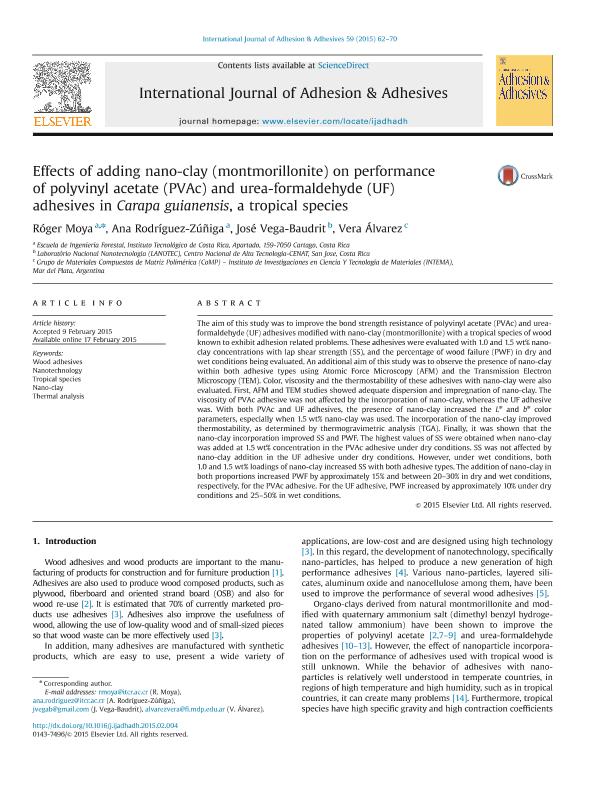Mostrar el registro sencillo del ítem
dc.contributor.author
Moya, Róger
dc.contributor.author
Rodriguez-zuñiga, Ana
dc.contributor.author
Vega-Baudrit, José
dc.contributor.author
Alvarez, Vera Alejandra

dc.date.available
2015-12-16T16:19:36Z
dc.date.issued
2015-02-17
dc.identifier.citation
Moya, Róger; Rodriguez-zuñiga, Ana; Vega-Baudrit, José; Alvarez, Vera Alejandra; Effects of adding nano-clay (montmorillonite) on performance of polyvinyl acetate (PVAc) and urea-formaldehyde (UF) adhesives in Carapa guianensis, a tropical species; Elsevier; International Journal Of Adhesion And Adhesives; 59; 17-2-2015; 62-70
dc.identifier.issn
0143-7496
dc.identifier.uri
http://hdl.handle.net/11336/2940
dc.description.abstract
The aim of this study was to improve the bond strength resistance of polyvinyl acetate (PVAc) and urea-formaldehyde (UF) adhesives modified with nano-clay (montmorillonite) with a tropical species of wood known to exhibit adhesion related problems. These adhesives were evaluated with 1.0 and 1.5 wt% nano-clay concentrations with lap shear strength (SS), and the percentage of wood failure (PWF) in dry and wet conditions being evaluated. An additional aim of this study was to observe the presence of nano-clay within both adhesive types using Atomic Force Microscopy (AFM) and the Transmission Electron Microscopy (TEM). Color, viscosity and the thermostability of these adhesives with nano-clay were also evaluated. First, AFM and TEM studies showed adequate dispersion and impregnation of nano-clay. The viscosity of PVAc adhesive was not affected by the incorporation of nano-clay, whereas the UF adhesive was. With both PVAc and UF adhesives, the presence of nano-clay increased the L∗ and b∗ color parameters, especially when 1.5 wt% nano-clay was used. The incorporation of the nano-clay improved thermostability, as determined by thermogravimetric analysis (TGA). Finally, it was shown that the nano-clay incorporation improved SS and PWF. The highest values of SS were obtained when nano-clay was added at 1.5 wt% concentration in the PVAc adhesive under dry conditions. SS was not affected by nano-clay addition in the UF adhesive under dry conditions. However, under wet conditions, both 1.0 and 1.5 wt% loadings of nano-clay increased SS with both adhesive types. The addition of nano-clay in both proportions increased PWF by approximately 15% and between 20-30% in dry and wet conditions, respectively, for the PVAc adhesive. For the UF adhesive, PWF increased by approximately 10% under dry conditions and 25-50% in wet conditions.
dc.format
application/pdf
dc.language.iso
eng
dc.publisher
Elsevier

dc.rights
info:eu-repo/semantics/openAccess
dc.rights.uri
https://creativecommons.org/licenses/by-nc-sa/2.5/ar/
dc.subject
NANO-CLAY
dc.subject
NANOTECHNOLOGY
dc.subject
THERMAL ANALYSIS
dc.subject
TROPICAL SPECIES
dc.subject
WOOD ADHESIVES
dc.subject.classification
Ingeniería de los Materiales

dc.subject.classification
Ingeniería de los Materiales

dc.subject.classification
INGENIERÍAS Y TECNOLOGÍAS

dc.subject.classification
Nano-materiales

dc.subject.classification
Nanotecnología

dc.subject.classification
INGENIERÍAS Y TECNOLOGÍAS

dc.title
Effects of adding nano-clay (montmorillonite) on performance of polyvinyl acetate (PVAc) and urea-formaldehyde (UF) adhesives in Carapa guianensis, a tropical species
dc.type
info:eu-repo/semantics/article
dc.type
info:ar-repo/semantics/artículo
dc.type
info:eu-repo/semantics/publishedVersion
dc.date.updated
2016-03-30 10:35:44.97925-03
dc.journal.volume
59
dc.journal.pagination
62-70
dc.journal.pais
Países Bajos

dc.journal.ciudad
Amsterdam
dc.description.fil
Fil: Moya, Róger. Instituto Tecnológico de Costa Rica; Costa Rica
dc.description.fil
Fil: Rodriguez-zuñiga, Ana. Instituto Tecnológico de Costa Rica; Costa Rica
dc.description.fil
Fil: Vega-Baudrit, José. Centro Nacional de Alta Tecnologia; Costa Rica
dc.description.fil
Fil: Alvarez, Vera Alejandra. Universidad Nacional de Mar del Plata. Facultad de Ingenieria; Argentina. Consejo Nacional de Investigaciones Científicas y Técnicas. Centro Científico Tecnológico Mar del Plata. Instituto de Investigación en Ciencia y Tecnología de Materiales (i); Argentina
dc.journal.title
International Journal Of Adhesion And Adhesives

dc.relation.alternativeid
info:eu-repo/semantics/altIdentifier/url/http://www.sciencedirect.com/science/article/pii/S0143749615000299
dc.relation.alternativeid
info:eu-repo/semantics/altIdentifier/doi/http://dx.doi.org/10.1016/j.ijadhadh.2015.02.004
Archivos asociados
